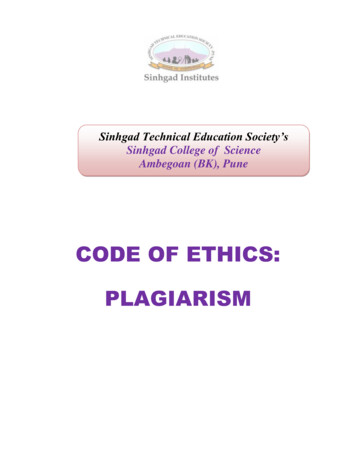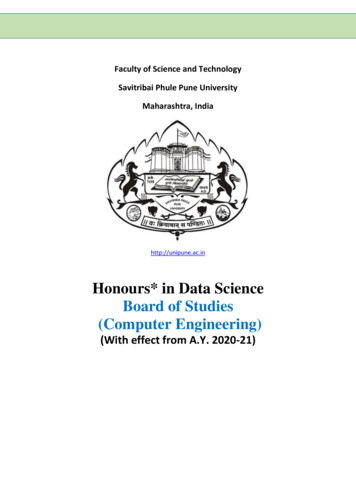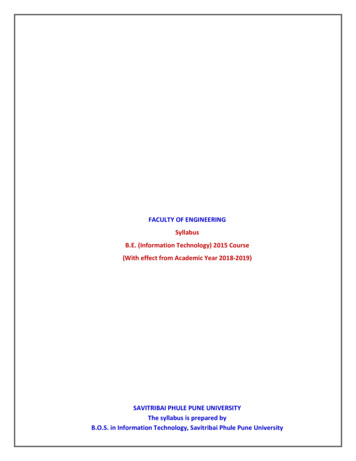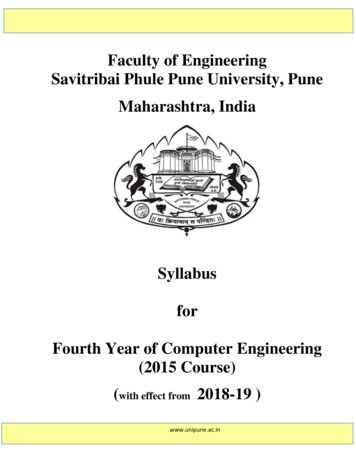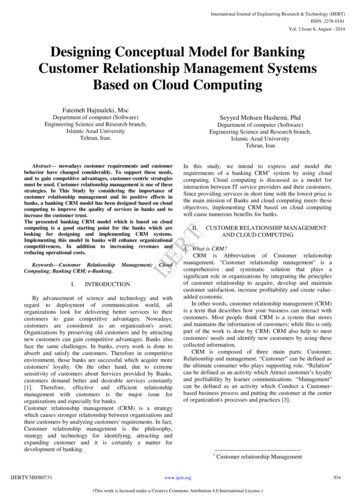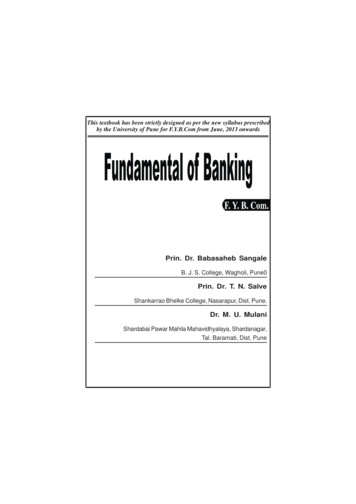
Transcription
This textbook has been strictly designed as per the new syllabus prescribedby the University of Pune for F.Y.B.Com from June, 2013 onwardsPrin. Dr. Babasaheb SangaleB. J. S. College, Wagholi, Pune0Prin. Dr. T. N. SalveShankarrao Bhelke College, Nasarapur, Dist. Pune.Dr. M. U. MulaniShardabai Pawar Mahila Mahavidhyalaya, Shardanagar,Tal. Baramati, Dist. Pune
SyllabusBanking and Finance - II (305 - B)(Financial Markets and Institutions in India)Term IUnit One: Evolution of Banking1.1 Origin, Meaning and Definition of 'Bank'1.2 Evolution of banking- Europe, USA & Asia1.3 Evolution of banking in India.1.4 Structure of Indian Banking SystemUnit Two: Functions of Bank2.1 Primary functions:A) Accepting deposits: Demand deposits: Current andSavings; No Frills Account, Time deposits-Recurring andFixed deposits, Flexi Deposits (Auto Sweep)B) Granting Loans and Advances- Term Loan, Short termcredit, Overdraft, Cash Credit, Purchasing, Discounting ofbills,2.2 Secondary functions:A) Agency Functions- Payment and Collection of Cheques,Bills and Promissory notes, Execution of standinginstructions, Acting as a Trustee, Executor.B) General Utility Functions: Safe Custody, Safe depositvaults, Remittances of funds, Pension Payments, Acting asa dealer in foreign exchange. ii .
Unit Three: Procedure for opening and operating ofdeposit account3.1 Procedure for Opening of Deposit Account: Know YourCustomer- Needs and Norms (KYC Norms), Application form,Introduction, Proof of residence, Specimen signature andNomination: Their Importance3.2 Procedure for Operating Deposit Account: Pay-in-slips,Withdrawal slips, Issue of pass book, (Current Savings orRecurring deposits), Issue of Cheque book, Issue of fixeddeposit receipt, Premature encashment of fixed deposits andloan against fixed deposit. Recurring deposits: Prematureencashment and loan against recurring deposit.3.3 a) Closure of accountsb) Transfer of accounts to other branches/Banks3.4 Types of account holdersa) Individual account holders- Single or joint, Illiterate,Minor, Married woman, Pardahnashin woman, Non residentaccountsb) Institutional account holders- Sole proprietorship,Partnership firm, Joint stock company, Hindu undivided family,Clubs, Associations and Societies and Trusts.Unit Four: Methods of Remittances4.1 Demand drafts, bankers' Cheques and TruncatedCheques4.2 Mail transfer and Telegraphic transfer.4.3 Electronic Funds Transfer- RTGS, NEFT and SWIFT. iii .
Term IIUnit Five: Lending principles, Credit Creation andBalance Sheet of a bank5.1 Safety, Liquidity, Profitability, Diversification of risksConflict between liquidity and profitability5.2 Multiple Credit Creation: Process and Limitations5.3 Balance sheet of a commercial bank.Unit Six: Negotiable Instruments6.1 Definition, meaning and characteristics of Promissorynote, Bill of Exchange and Cheque6.2 Types of Cheques- Bearer, Order and Crossed6.3 Types of Crossing- General and Special.Unit Seven: Endorsement7.1 Definition and meaning of endorsement7.2 Types of endorsement- Blank, Full or Special, Restrictive,Partial, Conditional, Sans Recourse, Facultative.Unit Eight: Technology in Banking8.1 Need and importance of technology in banking8.2 E-Banking: ATM, Credit card, Debit card, Tele Banking,Mobile Banking, Net Banking, SWIFT (Society for WorldwideInter-bank Financial Telecommunication)8.3 Concept and benefits of Core Banking Solution. iv .
In d e xTerm I1.Evolution of Banking1.1 to1.282.Functions of Bank2.1 to2.243.Procedure for Opening & Operating of3.1 to3.484.1 to4.285.1 to5.28Deposit Account4.Methods of RemittancesTerm II5.Lending Principles, Credit Creation andBalance Sheet of a Bank6.Negotiable Instruments6.1 to6.327.Endorsement7.1 to7.168.Technology in Banking8.1 to8.40. v .
1Evolution of Banking1.1 Origin of Banking1.2 Bank :1.3 Evolution of Banking in Other Countries :1.4 Evolution of Banking in India1.5 Structure of Indian Banking SystemIntroduction :Banking is an integral part of the modern economy. But thenature and functions of modern banks have evolved over a longperiod of time. The idea of banking evolved with the idea ofmoney.Banking business is mainly linked to lending. Moneylenderis to be found in every society-ancient or modern; advanced orbackward. The ten commandments of Moses, Quoran,Manusmrity, Kautilya’s Arthashastra all have references tomoneylenders and rate of interest. Modern banks also undertakeforeign exchange transactions. The priests in temples tookadvantage of the sanctity of the temples, collected people’s savings1.1
Fundamental of Bankingand did lending business. In the middle ages, banking businesswas carried by the individuals. Then came partnership and todayin all countries banking is carried out by joint stock companiesand is regulated by the Government.1.1 Origin of Banking :It is seen that banking transactions have been taking placesince last number of years. Even it is evidenced that the bankingsystem was prevailing at the time of Babilon culture. The bankswere in existence in Rome also. It was said that in the year 1171,the authorities of Venice had taken loan from the people for meetingthe expenses of war and the arrangements for repayment werealso made by them. Such loan was called as ‘Mot’ in Italianlanguage. The meaning of mot in German language is ‘bank’. Inthose days, there was German rule in many parts of Italy.Afterwards, in Italian language it was called as banco. The Germanword bank means a joint stock fund. This word bank was Italianisedinto banco when the Germans were masters of a great part ofItaly. Afterwards in France and England this word was used. It isseen that since 1646 the word ‘bank’ has been used in the articles.Later on there were many banks who started using the word bankin their names. e.g. Bank of Milan. However, there are somephilosophers according to whom the Italian word ‘banco’ meanstable. In the old days, the money lenders used to do bankingtransactions by keeping tables in the market and so the word ‘bank’has been evolved.1.2
Evolution of Banking1.2 Bank :1.2.1 Meaning :The word ‘Bank’ has been derived from the Latin word ‘bancus’or ‘banque’. The meaning of it in English is a bench. The earlybankers transacted their business at benches in a market place.According to some authorities, the word bank was originally derivedfrom German word bank. It means a joint stock fund. This word lateron was called as ‘banco’ in Italy when a great part of Italy wasruled by the Germans.A bank is a financial institution which deals with deposits andadvances and other related services. It receives money from thosewho want to save in the form of deposits and it lends money tothose who need it. A bank is a financial institution and a financialintermediary that accepts deposits and channels those depositsinto lending activities, either directly by loaning or indirectly throughcapital markets. A bank is the connection between customersthat have capital deficits and customers with capital surpluses.Due to their influence within a financial system and an economy,banks are generally highly regulated in most countries. Most banksoperate under a system known as fractional reserve banking wherethey hold only a small reserve of the funds deposited and lend outthe rest for profit. They are generally subject to minimum capitalrequirements which are based on an international set of capitalstandards, known as the Basel Accords.1.3
Fundamental of Banking1.2.2 Definitions :1) F.E. Perry :“The bank is an establishment which deals in money, receivingit on deposit from customers, hounouring customer’s drawingsagainst such deposits on demand, collecting cheques forcustomes and lending or investing surplus deposits until theyare required for repayment.”2) Walter Leaf :“A banker is an institution or individual who is always ready toreceive money on deposits to be returned against the chequesof their depositors.”3) Dr. Herbert L. Hart :“A banker is one who in the ordinary course of his business,honours cheques drawn upon him by persons from and forwhom he receives money on current accounts.”5) The Indian Banking Companies Act, 1949 :“Banking means the acceptance for the purpose of lending orinvestment, of deposits of money from the public repayableon demand or otherwise, and withdrawal by cheque, draft, orderor otherwise”.1.2.3 Characteristics / Features of Bank :Characteristics of a bank can be given as follows :1) Dealing in Money :Bank is a financial institution which deals with other people'smoney i.e. money given by depositors.1.4
Evolution of Banking2) Individual / Firm / Company :A bank may be a person, firm or a company. A banking companymeans a company which is in the business of banking.3) Acceptance of Deposit :A bank accepts money from the people in the form of depositswhich are usually repayable on demand or after the expiry of afixed period. It gives safety to the deposits of its customers. Italso acts as a custodian of funds of its customers.4) Giving Advances :A bank lends out money in the form of loans to those whorequire it for different purposes.5) Payment and Withdrawal :A bank provides easy payment and withdrawal facility to itscustomers in the form of cheques and drafts. It also bringsbank money in circulation. This money is in the form of cheques,drafts, etc.6) Agency and Utility Services :A bank provides various banking facilities to its customers. Theyinclude general utility services and agency services.7) Profit and Service Orientation :A bank is a profit seeking institution having service orientedapproach.8) Ever increasing Functions :Banking is an evolutionary concept. There is continuousexpansion and diversification as regards the functions, servicesand activities of a bank.1.5
Fundamental of Banking9) Connecting Link :A bank acts as a connecting link between borrowers andlenders of money. Banks collect money from those who havesurplus money and give the same to those who are in need ofmoney.10) Banking Business :A bank's main activity should be to do business of bankingwhich should not be subsidiary to any other business.11) Name Identity :A bank should always add the word "bank" to its name to enablepeople to know that it is a bank and that it is dealing in money.1.3Evolution of Banking in Other Countries :1.3.1 Evolution of Banking in Europe :The banking business is as old as authentic history. However,the early banking practices were in no way similar to the modernbanking practices. There is evidence of the existence of bankingin most of the ancient civilisations of the world. As early as 2,000B.C. Babylonions had developed a system of banks. Although thebusiness of banking is as old as authentic history, bankinginstitutions have since then changed in character and content verymuch, evolution of banking in Europe means the history of bankingin the following European countries.1) Banking in Greece and Rome :In ancient Greece and Rome the practice of granting creditwas widely prevalent. In Rome, the bankers were calledArgentarii, Mensarii or Callybistoe. The banks were called1.6
Evolution of BankingTabernoe Argentarioe. Some of the banks carried business ontheir own account and others were appointed by theGovernment of receive the taxes. They used to transact theirbusiness on similar lines as those of the modern bankers.People used to settle their accounts with their creditors bygiving a cheque or draft on the bank. If the creditor had also anaccount at the same bank, the account was settled by an orderto make the transfer of such money from one name to another.To pay money by a draft was known as prescribere andrescribere, and the draft was known as attribution. Thesebankers also received deposits and lend money. Loan bankswere also common in Rome. From these loan banks, the poorcitizens received loans without paying interest. They lend moneyfor a period of three or four years on the security of land.The bankers preserved their deposits fully at first, but laterbegan to use them for their own purposes, creating depositsand granting credits out of nowhere. Since the canonical lawbanned the charging of interest on loans, bankers would insteadpay “penalties” for “delays” in payment and in effect pay intereston a disguised loan, and justified any misappropriations on thisbasis. Fractional reserve banking has created periods ofgrowth, followed by an economical crisis and failure of banks.The authorities failed to enforce sound banking practices, andoften granted banks a government license to operate with afractional reserve, while taking advantage of easy loans tofinance governments and public officials. Some rules createdgovernment banks to reap the profits. But banks were stillrequired to guarantee deposits.1.7
Fundamental of Banking2) Italy :During the early periods, although the banking business wasmostly done by private individuals, may countries establishedpublic banks either for the purpose of facilitating commerce orto serve the Government one of such banks was the Bank ofVenice. It was established in 1157. It is supposed to be themost ancient bank. Originally, it was not a bank in the modernsense being simply an office for the transfer of the public debt.And it was in Florence, where the growing banking industrygained great importance by the fourteenth century. From thattime have the bankers begun to misuse a portion of theirdeposits, inevitably causing a boom and a recession. Thisrecession was triggered not only by, Neapolitan princes’massive withdrawal of funds, but also by England’s inability torepay its loans and the drastic fall in the price of Florentinegovernment bond. The public debt was financed by thesespeculative new loans created. A general crisis of confidenceoccurred, causing the most important banks to fail between1341 and 1346. The recovery did not come until after the plague.The powerful Medici bank initially didn’t accept demanddeposits. Later on, their reserve ratio gradually worsened, andby its end dropped even below 10 percent. The bank was ruinedby the end of the 14th century like its competitors, and all of itsassets fell into the hands of creditors.3) Spain :As early as 1349, the business of banking was carried on bythe drapers of Barcelona. There it was subject to official1.8
Evolution of Bankingregulation. The drapers were not allowed to commence thisbusiness until they had given sufficient security. During 1401,a public bank was established in Barcelona. It used to exchangemoney, receive deposits and discount bills of exchange, bothfor the citizens and for the foreigners. During 1407, the Bankof Genoa was established. The bank of Amsterdam wasestablished in 1609 to meet the needs of the merchants of thecity. It accepted all kinds of specie on deposits. These depositscould be withdrawn on demand or transferred from the accountof one person to another. The bank also adopted a plan bywhich a depositor received a kind of certificate entitling him towithdraw his deposit within six months. These written orders,in course of time, came to be used in the same manner as themodern cheques. It is interesting to note that most of theEuropean banks now in existence were formed on the modelof the Bank of Amsterdam.4) Germany and Polland :The Fuggers were financiers from 1485 to 1560 and are knownas a particularly important banking family in Southern Germany.Dutch bankers played a central role in establishing banking inthe Northern German city states. Berenberg Bank is the oldestprivate bank in Germany, established in 1590 by Dutch brothers,Hans and Paul Berenberg in Hamburg. The bank is still ownedby the Berenberg dynasty.5) Holland :Throughout 17th century, precious metals from the New World,Japan and other locales have been channeled into Europe,1.9
Fundamental of Bankingwith corresponding price increases. Thanks to the free coinage,the Bank of Amsterdam, and the heightened trade andcommerce, Netherlands attracted even more coin and bullion.These concepts of Fractional-reserve banking and paymentsystems went on and spread to England and elsewhere.1.3.2 Evolution of Banking in USA :1) 1791-1811 : First Attempt at Central Banking :At the urging of Treasury Secretary Alexander Hamilton,in 1791Congress established the First Bank of the United States,headquartered in Philadelphia. It was the largest corporation inthe country and was dominated by big banking and moneyinterests. Many agrarian-minded Americans, uncomfortablewith the idea of a large and powerful central bank, opposed it.By 1811, when the bank’s 20-year charter expired, Congressrefused, by one vote, to renew it.2) 1816-1836 : A Second Try Fails :By 1816 the political climate was again in favour of a centralbank, by a narrow margin,Congress agreed to charter theSecond Bank of the United States. But when Andrew Jackson,a central bank foe, was elected president in 1828,he vowed tokill it. His attack on its banker-controlled power touched apopular nerve with Americans, and when the Second Bank’scharter expired in 1836,it was not renewed.3) 1836-1865 : The Free Banking Era :State-chartered banks and unchartered “free banks” took holdduring this period, issuing their own notes, redeemable in goldor specie. Banks also began offering demand deposits to1.10
Evolution of Bankingenhance commerce. In response to a rising volume of checktransactions, the New York Clearing house Association wasestablished in 1853 to provide a way for the city’s banks toexchange checks and settle accounts.4) 1863 : National Banking Act :During the Civil War the National Bank Act of 1863 waspassed.This created national banks, which issued circulatingnotes that had to be backed by U.S. government securities. Anamendment to the Act required taxation on state bank notesbut not on national bank notes, effectively creating a uniformcurrency for the nation. Despite taxation on their notes, statebanks continued to flourish because of the growing popularityof demand deposits, which had taken hold during the FreeBanking Era.5) 1873-1907 : Financial Panics Prevail :Although the National Bank Act of 1863 established somemeasure of currency stability for the growing nation, bank runsand financial panics continued to plague the economy. In 1893a banking panic triggered the worst depression the UnitedStates had ever seen,and the economy stabilized only afterthe intervention of financial mogul J.P. Morgan.It was clear thatthe nation’s banking and financial system needed seriousattention.6) 1907 : A Very Bad Year :In 1907, a bout of speculation on Wall Street ended in failure,triggering a particularly severe banking panic. J.P. Morgan was1.11
Fundamental of Bankingagain called upon to avert disaster. By this time most Americanswanted reform of the banking system, but the structure of thatreform was cause for deep division among the country’scitizens. Conservatives and powerful “money trusts” in the bigEastern cities were vehemently opposed by “progressives.”But there was a growing consensus among all Americans thata central banking authority was needed to ensure a healthybanking system and provide for an elastic currency7) 1908-1912 : The Stage is Set for a Decentralised CentralBank :The Aldrich-Vreeland Act of 1908, passed as an immediateresponse to the panic of 1907, provided for emergency currencyissues during crises. It also established the National MonetaryCommission to search for a long-term solution to the nation’sbanking and financial problems. Under the leadership of Sen.Nelson Aldrich, the commission developed a banker-controlledplan. William Jennings Bryan and other progressives fiercelyattacked the plan; they wanted a central bank under public, notbanker, control.The 1912 election of Democrat WoodrowWilson killed the Republican Aldrich plan, but the stage wasset for the emergence of a decentralised central bank.8) 1914 : Open for Business :Before the new central bank could begin operations,theReserve Bank Organizing Committee, comprised of TreasurySecretary William McAdoo, Secretary of Agriculture DavidHouston, and Comptroller of the Currency John SkeltonWilliams,had the arduous task of building a working institution1.12
Evolution of Bankingaround the bare bones of the new law. But by Nov. 16,1914,the12 cities chosen as sites for regional Reserve Banks wereopen for business,just as hostilities in Europe erupted intoWorld War I.9) 1935 : More Changes to Come :The Banking Act of 1935 called for further changes in the Fed’sstructure, including the creation of the Federal Open MarketCommittee (FOMC) as a separate legal entity, removal of theTreasury Secretary and the Comptroller of the Currency fromthe Fed’s governing board, and the establishment ofmembers’terms at 14 years. Following World War II,theEmployment Act added the goal of promoting maximumemployment to the list of the Fed’s responsibilities. In 1956 theBank Holding Company Act named the Fed as the regulatorfor bank holding companies, and in 1978 the HumphreyHawkins Act required the Fed chairman to report to Congresstwice annually on monetary policy goals and objectives.10) 1980: Modern Banking Industry Reforms :The Monetary Control Act of 1980 required the Fed to price itsfinancial services competitively against private sector providersand to establish reserve requirements for all eligible financialinstitutions.The Act marks the beginning of a period of modernbanking industry reforms. Following its passage, interstatebanking proliferated, and banks began offering interest-payingaccounts and instruments to attract customers from brokeragefirms. Barriers to insurance activities, however, proved moredifficult to circumvent. Nonetheless, momentum for changewas steady, and by 1999 the Gramm-Leach-Bliley Act was1.13
Fundamental of Bankingpassed, in essence overturning the Glass-Steagall Act of 1933and allowing banks to offer a menu of financial services,including investment banking and insurance sales11) 1980 to 1990: Deregulation :Legislation passed by the federal government during the 1980s,such as the Depository Institutions Deregulation and MonetaryControl Act of 1980 and the Garn–St. Germain DepositoryInstitutions Act of 1982, diminished the distinctions betweenbanks and other financial institutions in the United States. Thislegislation is frequently referred to as "deregulation," and it isoften blamed for the failure of over 500 savings and loanassociations between 1980 and 1988, and the subsequentfailure of the Federal Savings and Loan InsuranceCorporation(FSLIC) whose obligations were assumed by theFederal Deposit Insurance Corporation (FDIC) in 1989.1.3.3 Evolution of Banking in Asia :Soon after independence, the governments of Central Asiarecognized that the transition to a market economy would requirethe supportive development of their banking and financial system,involving considerable capacity building in a sector that needed tobe reestablished virtually from scratch. As a result reform programswere designed and implemented throughout the 1990s, aimed atrestructuring and modernizing the components of a financialsystem so as 10 create conditions for sustainable economicgrowth.Essentially, the reform programs took place in two pluses. Inthe first phase, between 1993 and 1997, monetary Stabilizationexcept for Tajikistan became a priority. During this phase,1.14
Evolution of Bankinggovernments also tried to implement ambitious privatisationprograms in the small scale area and to develop a legal frameworksupporting a market economy, In the second phase, governmentfocused on strengthening the banking system, developing financialand legal infrastructure and fiscal stabilisation.a) The First Phase :During the first phase, the introduction of sovereign currencieswas accompanied by restrictive monetary politics, to containinflation. As a result high interest rate policies and formal andinformal restriction on convertibility were introduced andimplemented. High interest rates, low level of reserves, lack ofliquidity, economic and political instability and devaluationcontinued throughout 1995-96, together with consistentdollarisation of the financial system and an outflow of funds.b) The Second Phase :The combination of improved monetary policies structural andinstitutional reforms, and improved fiscal discipline eventuallybrought economic stability to the Central Asia region by themid-1990s. Inflation was contained and dropped fromhyperinflationary levels in 1993 to around 15-20 percent in 199798, sloping the devaluation of local currencies, which remainedrelatively viable until the Russian financial crisis of 1998. Inaddition, it the end of 1997 real gross domestic product (GDP)began to grow in the region.1.3.4 Evolution of Banking in England :Crowther has most succinctly described the evolution ofmodern banking. According to him, modern banking developed inEngland. Modern Banker, he adds, has three ancestors - themoneylender, the trader and the most typical of all, the English1.15
Fundamental of BankingGoldsmith. What he means by this is that modern bankingcombines the functions of these three businesses.Stages in Evolution of Banking in the England :1) The Moneylenders :As stated earlier, every society has moneylenders. Thoughhated, they are to be found in every society because theyperform the essential function of giving loans to the needy. Thereare people whose expenditure sometimes exceeds theirincome. The moneylender helps them to tide over their difficulty.Experience taught moneylenders how to assesscreditworthiness of a borrower and how to recover loans.However, they did the business of lending on their own capitaland often exploited the borrowers. Modern banks’ primaryfunction is lending and giving more loans. For productivepurpose, they collect deposits. Then banks normally give loanswhich benefit the borrowers, other banks and the societyas well.2) Merchants or Traders :They act as intermediaries between producers and consumers.The grain merchant buys grains from the farmers and sells itto the consumers. Similarly, banks are said to deal in money.They collect deposits from common people and lend them outto some borrowers. They act as intermediaries between thesavers and the producers. In the middle ages, journeys wererisky. Therefore, small merchants would keep money with awell-known rich trader and get receipts for the deposit. Onstrength of these receipts, they transacted business. Today’s1.16
Evolution of Bankingbanks issue letters of credit which makes transactions possiblebetween unknown parties. Previously bankers were calledmerchant bankers who mainly exchanged coins for tradingpurposes.3) The English Goldsmith :Modern banks do not only deal in money but they, in a specialsense, create money. This typical heritage comes from theEnglish goldsmith. In the mediaeval London, there was notmuch safety against thefts and dacoity. The English goldsmithshad big safes and perhaps guards. The common people wouldkeep their valuable jewellery and gold coins for safety with thegoldsmiths who used to charge rent for this service. Thegoldsmiths also gave receipt for the deposit of valuables. Thedepositors were sure to get back their deposits any time onproduction of the receipts. Later on, the faith in the honesty ofthe goldsmiths increased. The depositors were sure to get backtheir deposits any time on production of receipts. Later, insteadof personally withdrawing deposits, they started giving writtendirections to the goldsmiths to pay a part of the deposit to thebearer of the letter. This was the beginning of modern cheque.When goldsmiths realised that their receipts were used to settletransactions, i.e. used as money, they started giving loans byissuing more receipts than the deposits they had and thesereceipts were also accepted by people because they werebacked by the credit of the goldsmith. Goldsmiths took care toreturn deposit on demand which increased trust in them.4) Establishment of Various Banks :In the 16th century, many public banks are established in thecountries of Europe. e.g. Bank of Venice established in the1.17
Fundamental of Bankingyear 1515, Bank of Sweeden established in the year 1556. Inthe year 1676, banking functions are carried out by theGoldsmiths in England by providing loans to English rulers.British ruler Charles III refused to repay the loan to theGoldsmiths. This was the reason for the public distrust ofGoldsmith. Public started demand their deposits from theGoldsmiths. In the same way, the banking business was to beasked to be handed over to the companies. It was essential forthe protection of public money and to regulate rate of interest.It was resulted in the establishment of the Bank of England inthe year 1694. In the year 1700, a right of issue of notes wasgiven to this bank. It started accepting deposits from public.Joint stock banks were established in the year 1823. Thesebanks were given permission to do banking business outsideLondon from 1827. These banks are established on the principleof limited responsibility after 1858. In the beginning of 19thcentury, the banking business was developed in the othercountries also.Later on banks were allowed to issue paper notes. In the duecourse of time, this right was restricted to the Central Bankonly. This is how modern banking has evolved over a long periodof time.1.4 Evolution of Banking in India :Modern banking as evolved in England was introduced by theBritish during their rule in India. Naturally, today’s Indian banking issimilar to British banking. However, it does not mean that bankingwas unknown to India. The essence of banking is lending for1.18
Evolution of Bankingproductive purposes. In fact, India was a major partner ininternational trading and was a big producer of steel, cloth, spicesand luxurious articles. There are references to rate of interest,security of the loans in the Manusmrity. Kautilya in the ‘ArthaShastra’ mentions regulation of
Evolution of Banking 1 1.1 Introduction : Banking is an integral part of the modern economy. But the nature and functions of modern banks have evolved over a long period of time. The idea of banking evolved with the idea of money.Banking business is mainly linked to lending. Moneylen



